We Heard Gunshots Outside of the Saloon
- Nathan and Lori
- Sep 15, 2017
- 7 min read
“The brave don't live forever, but the cautious don't live at all.
The only thing that's truly terrifying is the unlived life.”
Bill See
State 14: South Dakota - August 28, 2017
Nate

We woke up at a campsite in the tiny town of Hettinger right on the North & South Dakota border. I can’t think of a better way to start a day than with a countdown to the state border of the 13th state on our cross country journey to discover America and find a new state to call home; South Dakota: Great Faces Great Places. Not a bad state slogan if I do say so myself, especially when compared to others we have visited. Of course South Dakota is most famous for Mount Rushmore hence the reference to the “great faces”. However, the reference to the “great places” lets me know there is so much more the see and do in the state, other than the obvious. We can’t wait to see the “great places” we will come across during our week in South Dakota.
After driving 2 ½ hours through the gorgeous grasslands of Northwestern South Dakota, we arrived at Belle Fourche, SD, the site of the Cross Country Couple's “Road Side Attraction” for the state of South Dakota: The Geographical Center of the United States! Seriously? How could it possibly be the exact geographical center point of the US is in South Dakota? In 1912, the center of the US was determined to be just outside of Lebanon, Kansas, and if you look on a Google maps, it makes perfect sense. However, in 1959 when Alaska and Hawaii became the 49th and 50th states, it moved the geographic center of the United States approximately 550 miles North. According to the U.S National Geodetic Survey, the geographical center of the United States is at (Lat. 44 58 02.07622(N) Long. 103 46 17.60283(W)), or more commonly known as Belle Fourche, SD. However, if you wanted to be precisely accurate, the geographical center of the US is 20 miles North of the town Belle Fourche, ND in a privately owned cow pasture. However, we did want to trespass on private property, and risk being chased by charging bulls across the prairies of rural South Dakota.
We proceeded to the visitor’s center in Belle Fourche, the location of a monument commemorating the town's designation of the being the center of the US. Behind the visitor’s center was a massive granite compass rose engraved with the image of the US. In the middle of the of the compass rose was a raised metal medallion commemorating Belle Fourche’s centralized location. Surrounding the monument were 50 flag poles, with each depicting the flag of each state. Of course Lori and I had to take pictures of us standing on the monument in the center of America. Please see the pictures below.
Lori
After leaving Belle Fourche we drove 30 miles west to visit the Cross Country Couple's Can’t Miss Attraction for the state of South Dakota “The site of the largest motorcycle rally in the entire world; Sturgis, SD”. The Sturgis Motorcycle Rally is an annual 10-day event held during the first full week of August. On August 14, 1938, the Sturgis Motorcycle rally was founded by Clarence “Pappy” Hoel, and his small motorcycle club called the Jackpine Gypsys. Attendance has grown over the years to 500,000 attendees in 2016, and the rally generates on average 800 million dollars into the South Dakota economy annually. We walked up and down the Main Street in Sturgis, which was a ghost town. It was hard to imagine a mere 2 weeks ago the town was packed with hundreds of thousands of people and their roaring bikes. Please see the pictures below.
Next, we headed to the Sturgis Motorcycle Museum which features vintage bikes, significant artifacts, and memorabilia related to the history of motorcycling and the Sturgis Rally.
Although a wide variety of bikes were on display, two bikes stood out among all others. The first bike of interest we found tucked away in the far corner of the Sturgis Museum basement. It was a 1913 Indian Bike, which once belonged to the world famous silent movie actor, Charlie Chaplin. It’s hard to image Charley Chaplin on a motorcycle, but apparently he enjoyed riding. The motorcycle was given to him to by the Indian Motorcycle Company in 1914. While performing a show in the Middle East in 1926, the King of the Saudi Arabia offered to buy Chaplin’s bike for $500,000, and who would turn down such a lucrative offer? The bike remained in Saudi Arabia until 1990, when an American soldier saved the King of Saudi Arabia’s life after an assassination attempt by Islamic terrorists. As a token of the Kings appreciation, he gave the soldier Charlie Chaplin’s Motorcycle. For some unknown reason, this historic bike currently sits in the basement of the Sturgis Museum. Please see the pictures below.
The second bike in the Sturgis museum which caught our eye was owned by a man named David Barr. David Barr is an American Vietnam War Veteran, who lost both of his legs in a mine explosion, and with the aid of prosthetics, he completed his tour of duty. In 1994, he set a world record for being the first double amputee to ride a motorcycle 83,000 miles around the world, and in 2000 was inducted into the AMA Motorcycle Hall of Fame. Today, Barr owns a motorcycle touring business in Bodfish, California, and continues to raise awareness for the disabled. What an inspirational person! We would love to meet him when we get to California! Please see the pictures below.
Many years ago, my late mother went on a 3-week cross country road trip on the back of a motorcycle, and had the time of her life. Sturgis was one of the places she visited. It has been comforting seeing some of the same sites on my cross country trip as my mom. I used to ride a lifetime ago, and Nate’s father used to as well. After visiting the Harley Museum and Manufacturing Plant in Wisconsin and now Sturgis, SD, we are both feeling the urge to get back into the wind! I can’t explain why! I guess it is just in our blood!
Nate
After departing Sturgis, we drove 30 miles across the Black Hills to the Cross Country Couple's chosen historic site for the South Dakota: Deadwood, SD. Deadwood has a very dark and interesting past. In 1870, the town was illegally founded on land belonging to the Native Americans. After gold was discovered in the Black Hills in 1874, the population swelled to 5,000 people giving rise to prostitution, gambling and lawlessness. In the years that followed, the town: was one of the first to have electricity, burned to the ground twice, and was the first small town in the US to legalize gambling in 1989. With the lawlessness tamed, and prostitution banished, Deadwood, SD is a now a popular tourist destination, and the entire town is a National Historic Landmark. However, the town of Deadwood will always be famously known as the place where Wild Bill Hitchcock was murdered.
Wild Bill Hitchcock was a driver, showman, soldier, spy, lawman, scout, gunfighter, gambler and folk hero of the American West. On August 2, 1876, He was playing 5 card stud in Nuttal & Mann's Saloon in Deadwood. Jack McCall entered the saloon, and shot Hickok in the back of the head point blank killing him instantly. The card hand held by Hickok at the time of his death were Aces and 8’s, which has come to be known as the deadman’s hand. McCall was arrested, charged with murder, tried in Deadwood, but found not guilty. The not guilty verdict was over turned, because Deadwood is an illegal town located Indian territory. The second trial was held in Yankton, the Capitol of the Dakota Territory. McCall was found guilty of Hickok’s murder, and hanged on March 1, 1877
Upon arriving in Deadwood, SD, the first stop we made was to have a drink in the bar where Wild Bill Hickok was murdered. Although the entire town had burned down twice since then, historians have been able to determine the exact location where the murder occurred. Today, the Original Saloon #10 stands in the same location. The saloon has been modeled to mirror what the Nuttal & Mann's Saloon would have looked like back in Hickok’s time. They even recreated the gambling room where the murder occurred, and offered overpriced tours, which we declined. So here we were sitting in a gorgeous 19th century bar in the middle of an old western frontier town sipping on our virgin cocktails watching the day waste away. All of a sudden, we hear a huge ruckus erupting right outside the saloon. A group of men were yelling at each other, and then a series gun shots erupted. Just as I was about to hit the deck, and throw myself on top of Lori, the bartender, sensing our anxiety, told us it was just the towns historical re-enactors. He suggested we go outside and watch the show. We exited the saloon just in time to see Jack McCall apprehended by the Deadwood's Sheriff and being led to the courtroom for trial.
The trial of Jack McCall was a comedic variety show put on by the historical re-enactors. Admission was $6 per person, and the show was hilarious. It began unexpectedly with the entire cast playing instruments and singing a series of old western songs. In the actual trial in 1876, the jury consisted or local gold miners. Since there were no gold miners present, the cast recruited 12 children “minors” to serve as the jury. Once the trial commenced, we were all caught off guard as they beginning calling random members of the audience to the stand to testify as witnesses. The show lasted an hour, and was extremely entertaining. You can tell the re-enactors really have a passion for what they do.
We spent the reminder of the day meandering around town, and taking in all of the sites.
Only in Deadwood will you see the pictured below.
Albeit a little touristy for our taste, visiting Deadwood was an entertaining way to learn about the wild history of this old western town. After departing, we drove 15 minutes west to a Walmart in Spearfish, SD. Tomorrow, we visit Mount Rushmore, and we can’t wait!



































































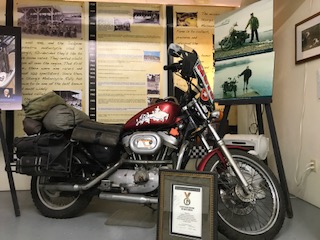

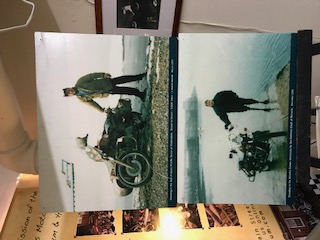

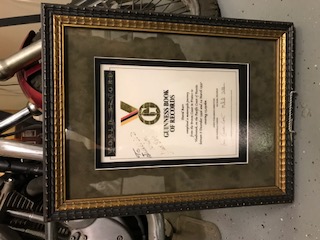

























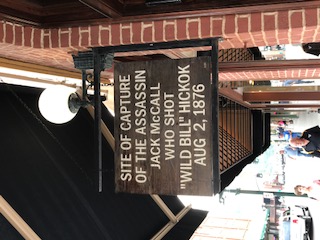





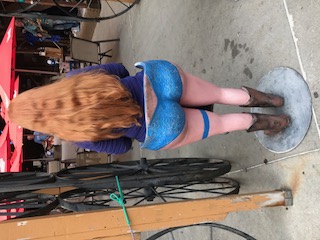




Comments